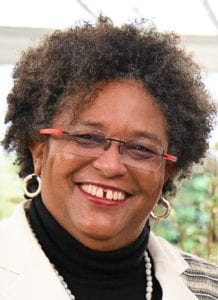
Women in power are playing a significant role in promoting state environmentalism. In their 2005 study “Gender Equality and State Environmentalism”, Kari Norgaard and Richard York analyzed the factors that influence state environmentalism and the ratification of environmental treaties. The study shows that a critical aspect of effecting change in the realm of environmental issues and climate change mitigation involves the equitable inclusion of women in legal policies as a higher representation of women in parliamentary bodies is associated with an increased likelihood of ratifying environmental treaties. Also, the correlation between gender representation and state environmentalism appears to be more pronounced than any other factor examined.
Additionally, Norgaard and York’s research has found a concerning correlation between foreign direct investment and a lack of focus on environmentalism in smaller countries, which may prioritize economic growth over environmental concerns. This raises questions about whether developed nations like the U.S. and U.K. prioritize their own economic interests over global environmental protection. The study also suggests that capitalism itself may be contributing to the environmental crisis, emphasizing the need for international action. In light of these findings, countries that provide foreign aid may not necessarily support greener policies in recipient nations, thereby emphasizing the critical need for prompt and decisive action on a global scale (513).
Furthermore, feminist theorists have long argued that sexism and environmental degradation share common structural elements or mutually reinforcing factors. Norgaard and York’s findings support this claim, as well as the idea that gender differences in environmental concern, risk perception, and social movement participation may have broader social implications, potentially influencing state policy. The UN Commission on the Status of Women has called for a minimum of 30 percent female representation in Parliament for women to have a meaningful impact on decision-making, yet as of 1999, only eight of 130 nations met this threshold (514). This underscores the need for increased female representation in politics to promote gender-sensitive and environmentally conscious policies.
To highlight this need, Norgaard and York focus on two countries, Norway and Singapore, to further delve into the relationship between gender and the ratification of environmental treaties. According to Norgaard and York, the two countries, despite being affluent, show different levels of support for both gender equality and environmental treaties; however, Norway has a high level of support for both, with a significant percentage of women in Parliament and ratification of a large number of treaties, while Singapore shows low levels of support for both measures (515).
Women Leading the Charge: A Look at Two Influential State Environmental Policy Makers
As demonstrated by Norgaard and York, the leadership of women in power is crucial in promoting state environmentalism. By prioritizing sustainable policies that benefit both the environment and communities, they are making a significant impact in addressing the pressing environmental challenges we face.
This year, to celebrate International Women’s Day, two such leaders were named as one of Reuters’ Twenty-five Trailblazing Women Leading the Fight Against Climate Change:
Mia Mottley, Barbados Prime Minister – (Reuters, 2023)

During COP27, Mia Mottley, the Prime Minister of Barbados, gave an impassioned speech highlighting the inequity faced by poor people in the Global South. Mottley argued that the people, whose “blood, sweat and tears financed the industrial revolution,” are now unfairly bearing the brunt of climate change, while richer nations fail to meet their commitments. This statement electrified the audience, as it spoke to the core of the issue of climate justice. Mottley’s leadership in advocating for marginalized communities has been instrumental in garnering support for the Bridgetown Initiative, which aims to revolutionize the financial system to channel trillions of dollars towards the fight against climate change.
As an elected leader with a strong mandate, Mottley has an ambitious plan to phase out fossil fuels by 2030. She envisions every home having access to solar panels and electric vehicles and has worked to implement action plans for ecosystem restoration in Latin America and the Caribbean. Her contributions extend beyond climate change, as she also co-chairs the Global Leaders Group on Antimicrobial Resistance, demonstrating her commitment to tackling global health issues. Mottley’s vision and leadership exemplify the type of bold action needed to address the complex challenges facing the world today.
Mottley’s noteworthy achievements are a reflection of her unwavering commitment to safeguarding the environment and enabling communities at a grassroots level, making her a deserving recipient of the 2021 Champions of the Earth Award for Policy Leadership. The Champions of the Earth and Young Champions of the Earth, hosted by the United Nations Environment Programme (UNEP), acknowledges and celebrates the achievements of individuals, groups, and organizations whose initiatives make a profound difference in protecting the environment. These awards, which are presented on a yearly basis, are considered the UN’s most prestigious environmental honors, and aim to recognize those who have had a transformative effect on the environment (UNEP, 2023, Champions of the Earth, Laureates).
To learn more about this important award and the incredible activists who have received it, visit the Champions of the Earth website at https://www.unep.org/championsofearth/about-award.
Marina Silva, Environment Minister of Brazil – (Reuters, 2023)

Brazil’s new environment minister, Marina Silva, has a personal connection to the Amazon rainforest, as the daughter of poverty-stricken rubber tappers. Silva’s family suffered tragedy when her two sisters and mother died from diseases brought by the construction of a highway near their home. She became a trade unionist and founded the empates movement with Chico Mendes and played a key role in organizing peaceful protests against the expulsion of rubber-tapping communities from their forest homes. Mendes was assassinated by cattle ranchers, but Silva continued the fight, ultimately leading to the creation of 2-million-hectares of tropical forests as sustainable extractive reserves, managed by Amazonian traditional communities (Marina Silva, 2022).
Silva was first appointed as Brazil’s environment minister by Brazil’s then president, Luiz Inácio Lula da Silva in 2003, and during her tenure, Amazonian deforestation was reduced by 70%. However, she left the role in 2008, frustrated by the lack of progress made by the government in tackling deforestation. Now, she has returned to the position under Lula’s second presidency, after he committed to taking stronger action to end deforestation. Her personal experiences and activism in defense of the Amazon rainforest make her a powerful and committed leader in the fight against deforestation, and her return to the role of environment minister is a promising sign for the future of Brazil’s environmental policies.
Silva’s impressive accomplishments, a testament to her dedication to protecting the environment and empowering local communities, earned her the 1996 Goldman Prize. The Goldman Environmental Prize is a prestigious award that recognizes grassroots environmental activists from around the world. Winners from six different continents are chosen based on their exceptional bravery and commitment to protecting the environment, often in the face of significant personal risk. Their stories serve as an inspiration to all of us, encouraging us to take action to protect the planet we call home.
To learn more about this important prize and the incredible activists who have received it, visit the Goldman Environmental Prize website at www.goldmanprize.org.
Exemplifying Female Representation and Grassroots Activism in Environmental Protection
Mia Mottley and Marina Silva personify Norgaard and York’s research and findings in different ways.
Mottley’s leadership in promoting climate justice and sustainable development aligns with their research on the critical role of female representation in promoting gender-sensitive and environmentally conscious policies. As a female leader and advocate for climate justice, Mottley embodies the idea that gender differences in environmental concern, risk perception, and social movement participation may have broader social implications, potentially influencing state policy.
In contrast, Silva’s personal and political commitment to protecting the Amazon rainforest supports Norgaard and York’s emphasis on the importance of grassroots activism in addressing environmental issues. Silva’s own experiences growing up in a rubber-tapping community and her involvement in the empates movement demonstrate the significance of community-led efforts to protect the environment. Furthermore, her leadership in organizing peaceful protests against the expulsion of rubber-tapping communities highlights the crucial role that social movements can play in addressing environmental issues, which Norgaard and York emphasize as essential for creating the political will necessary for enacting effective environmental policies.
Women leaders are paving the way for state environmentalism, setting an example for others to follow and demonstrating the importance of sustainable policies. Their efforts are critical in emphasizing the need for collective action to address environmental challenges and lead the way towards a greener future. As we navigate this urgent need for collective action, recognizing and supporting women’s leadership in politics is more critical than ever, as it will have far-reaching benefits for our planet and society.

According to the UN, the percentage of women in lower and single houses of national parliaments worldwide was 22.4% in 2015, but it has increased to 26.2% as of January 1, 2022. Women’s representation in local governments is slightly over one-third. However, if progress continues at this rate, it will take another 40 years for women and men to have equal representation in national parliaments (UN, 2022 Status Report, Goal 5). These statistics emphasize the ongoing gender inequalities in women’s representation in government, which have implications for the development of state environmental policy. (United Nations Statistics Division).
The increasing number of women in political leadership positions is driving advocacy for policies prioritizing environmental protection and community wellbeing. This shift is particularly important given the pressing environmental challenges and the need for collaborative action to mitigate climate change impacts.
THE HAND THAT ROCKS THE CRADLE IS THE HAND THAT RULES THE WORLD – A poem by William Ross Wallace (1819-1881)
Works Cited:
Marina Silva – Goldman Environmental Prize. Goldman Environmental Prize –, 26 Oct. 2022, www.goldmanprize.org/recipient/marina-silva.
“Mia Mottley.” Champions of the Earth, www.unep.org/championsofearth/laureates/2021/mia-mottley.
Norgaard, Kari Marie, and Richard York. “Gender Equality and State Environmentalism.” Gender & Society, vol. 19, no. 4, SAGE Publishing, Aug. 2005, pp. 506–22. https://doi.org/10.1177/0891243204273612.
Proportion of Seats Held by Women in National Parliaments (%) | Data. data.worldbank.org/indicator/SG.GEN.PARL.ZS?end=2021&start=2021&view=map.
Slavin, Terry. “Twenty-five Trailblazing Women Leading the Fight Against Climate Change.” Reuters, 10 Mar. 2023, www.reuters.com/business/sustainable-business/twenty-five-trailblazing-women-leading-fight-against-climate-change-2023-03-07.

Hi Rose – what a great post! I enjoyed reading about the accomplishments of theses amazing women. You picked great examples of how women’s voices can contribute to these discussions. Certain events in our lives can easily shape the path we take, and Marina Silva’s family tragedy is prime example of that.
Funny you should provide a statistic from the UN website – I had found a similar one to report! It’s amazing that it would take so long for men and women to become equal within the government and in policy making decisions.
Overall, it seems that other countries are much more afvance when it comes to these issues, particularly where women are involved in government and lawmaking. It is my hope that the US follows these trends, and more women commit their time to these causes so that this timeline progresses faster!
Hi Amanda,
Thank you for your kind words. I’m glad that you found the accomplishments of these remarkable women inspiring. It is true that certain events in our lives can shape our paths, and Marina Silva’s personal tragedy has definitely played a role in her passion for environmental activism. It is important to recognize that the contributions of women like her can have a significant impact on shaping policies and decisions that affect the world we live in.
I’m glad to hear that you also found statistics about gender inequality in government and policymaking. It’s an important issue that needs more attention, and we should work towards a future where women have equal representation and participation in all aspects of society. And while some countries are ahead of others when it comes to gender equality, progress can always be made, and we can all do our part to push for change. I agree with you that it would be great to see more women involved in government and lawmaking in the US, and I hope that day comes soon.
Rose,
I love that you decided to highlight actual women policymakers in your post. Mia Mottley and Marina Silva absolutely illustrate your point—women are intelligent, driven, and ingenuitive leaders. Especially when it comes to environmental concerns and treaties. It’s interesting to me that Brazil has an Environment Minister! Is it common for other nations to have one as well, or is this something unique to Brazil?
Both of the women that you talk about in your post would be in good company with Vandana Shiva! They’re all world-changers.
An unfortunate addition to the Norgaard and York argument of the gender gap in Parliament, which you highlight in your post, is that this gender gap doesn’t just end at the law-making or corporate level. It trickles down to even a consumer’s level. In an article titled “The Eco Gender Gap: Why Is Saving The Planet Seen As Women’s Work?” written by Elle Hunt for The Guardian, she explains how most men aren’t even aware of the eco-crisis. She writes,
“It was not long ago that, if you wanted to reduce the impact of your consumer choices on the environment, your only option was to use your own shopping bag. These days, the eco-minded shopper is overwhelmed with “green” choices. With the rise of reusable pads and menstrual cups, your period can now be plastic-free. Cosmetics increasingly come in glass and aluminium containers. Even hosiery brands are swapping nylon for more eco-friendly material.
Given the devastating toll of consumer waste on the health of the planet, you may find this visible drive towards sustainability on supermarket shelves cheering. But if you are a man, you may not have even noticed it: most eco-friendly products are marketed to women.
There is an obvious (and depressing) reason for this: women are not only more powerful consumers, but also disproportionately responsible, still, for the domestic sphere. The result of this is what the market research firm Mintel has termed an “eco gender gap”, where green branding might as well be pink.”
That was super eye-opening to me and really underscores Norgaard and York’s argument. The environment is seen as women’s concern and women’s problem to solve because men are absolved of the responsibility. And those are the men who are more often than not given policy-making power in Parliament over women candidates.
Like you’ve exemplified Mottley and Silva, Hunt points to AOC and Greta Thunberg as high-profile climate campaigners—both young women.
In a powerful summarizing statement, Hunt adds, “It sometimes seems that women are getting more desperate about trying to solve problems created by men.”
If you’d like to check out the whole article, here is the link:
theguardian.com/environment/2020/feb/06/eco-gender-gap-why-saving-planet-seen-womens-work
Hi Jasmine,
My apologies for not responding sooner. Your comment was in my spam folder, and I did not notice it sooner.
You raised an interesting question about whether it is common for other nations to have an Environment Minister, or if this is unique to Brazil. While I am not an expert in this area, I can tell you that many countries do have ministers or secretaries on specific departments responsible for the environment or natural resources. However, the specific title and level of authority may vary. For example, in the United States, the Environmental Protection Agency (EPA) is a federal agency responsible for protecting human health and the environment. Similarly, in Canada, there is a Minister of Environment and Climate Change. I will certainly have to look it up now that you mentioned it.
I completely agree with your point about the gender gap in environmentalism and sustainability, and how it extends beyond politics and corporate leadership to everyday consumer choices. Women are often expected to be the primary caretakers of their households and families, and this expectation often results in gendered marketing and product design, which further emphasizes the notion that environmentalism is a “feminine” concern.
However, as you noted, women are also leading the charge in addressing environmental issues and advocating for sustainability. It is so encouraging to see young women like AOC and Greta Thunberg, who is much younger, becoming high-profile climate campaigners and inspiring others to take action. Hopefully, this will lead to greater awareness and engagement on environmental issues across genders and generations. Thanks for sharing the Hunt article. I will certainly read it.
Hi Rose,
What a wonderfully written blog entry that outlined the correlation between women in representation and state environmentalism. I was pleased to see that you included the remarkable Marina Silva in your post as well as Mia Mottley, a key figure in the fight for environmentalism whose work I was unfamiliar with until I read your piece, so thank you! I found it crucial that you included the UN Commission on the Status of Women’s recommendation for a minimum of 30 percent female representation in national governments. It baffles me to read this statistic both because as you mention, we are far from meeting this globally, but also to see how minimal of a percentage recommended for women in power. Why 30 percent and not 50? While some may argue at least it is “something,” it is far not enough in granting gender equality and elimination of oppression, specifically protection of the environment as we focused on this week. Joni Seager has a wonderful book titled, “The Women’s Atlas” in which she details statistics on women’s oppression in several categories from health, work, education, to power. In her section on women’s rights in regards to power status, she writes that the world average of women in national governments has increased from 3 percent in 1945 to 23 percent in 2017 (Seager 190). In 72 years, this average has only increased 20% while greenhouse gas emissions and deforestation rates have risen at far larger rates. Another statistic that stood out to me was the comparison of the United States to that of other nations. You draw upon Norgaard and York’s example of the elevated levels of support for gender equality and environmentalism in Norway; looking at the statistics provided by Seager, according to measurements taken in 2017, Norway’s women representation in national government was at 40 percent and over while the United States was at 10-19 percent (Seager 190). Many countries of the Global South held no women in government at all. When we think back to our unit on non-Western ecofeminism, this is critical as protecting the natural world is a means of protecting the survival of women who are continuously in direct contact with exploitation of the land. While patriarchy and capitalist ideologies continue to dominate political economies, the health of all forms of life suffer. The quote you included from Mottley resonated with me; “The people whose blood, sweat and tears financed the industrial revolution are now unfairly bearing the brunt of climate change, while richer nations fail to meet their commitments.” This statement is powerful. As countries of the Global North coupled with androcentric tendencies contain to dominate and pollute the land out of selfishness without sympathy to the effect this has on all life across the globe, those most marginalized are still unable to have their voice represented and heard in policy making decisions as privilege continues to take power. Even in the United Nations–an international organization aimed at maintaining peace, security, and human rights–there is still disproportionate women representation. It is quite interesting that the UN System of Food & Agriculture Organization is represented by only 22 percent of women senior managers while women and girls are the most likely to face the effects of food insecurity, an environmental issue (Seager 195). This all goes to say, Norgaard and York highlight a critical thesis in the connection of women political representation with state environmentalism. As your own blog entry and the statistics I hope to have introduced to you present, women representation is needed. The oppression of nature is connected with the oppression of women and therefore, with an increase in gender equality throughout the government, an expansion in the development of policies rooted in environmentalism support will be imminent.
If you are interested in reading more about the statistics of women in power and/or various other topics of women’s status globally, here is the citation information for the book referenced in my comment:
Seager, Joni. The Women’s Atlas. Penguin Random House, 2018.
Best,
Kylie Coutinho
Hi Kylie,
I’m glad you found my post interesting and that it helped you discover new figures in the fight for environmentalism.
You raise an important point about the recommended minimum of 30% female representation in national governments and why it is not 50%. It is definitely a question worth asking, and I think the answer lies in the fact that even achieving 30% is still a significant challenge in many countries. However, I agree with you that it is not enough and that we need to strive for full gender equality in all spheres of life, including political representation.
Thank you also for sharing the statistics from Joni Seager’s book, “The Women’s Atlas.” It is alarming to see how slowly women’s representation in national governments has increased over the years, and how low it still is in many countries. The comparison between Norway and the United States is particularly striking, and it underscores the importance of having more women in positions of power to address issues like climate change.
I appreciate your insights on the connection between women’s political representation and environmentalism. As you mentioned, the oppression of nature is intimately linked to the oppression of women, and we cannot hope to achieve a sustainable and just world without addressing both of these issues.
Thank you again for your insights and the book recommendation!
Hi Rose,
Thank you for your post and for introducing some of the achievements of Mottley and Silvia. I enjoyed learning more about these politicians and their work!
I was also glad that you brought up Norgaard and York’s case study of Singapore and Norway. While I felt the arguments Norgaard and York made were compelling and logical, I had several questions about the methodology that they used in their study. Norgaard and York asserted that it is important to distinguish gender equality from general social and political freedom. They wrote that they controlled for this factor by using the Freedom House’s 1997 rating of political freedom. However, when accessing that study, one can see that in 1997, Singapore was rated by Freedom House as “partially free,” with political rights at 4 out of 7 and civil liberties at 5 out of 7 (with 1= most free and 7=least free) (p. 580). Conversely, Norway gets the highest rating of freedom at “free” with a 1 rating in both categories (Freedom House, 1997, p. 580). Norgaard and York wrote that they chose Singapore and Norway to compare because they had similar economic and developmental progress, but differences in gender equality and environmental protection. However, according to the Freedom House’s rating, these two countries also had significant differences in political freedom. Therefore, without a clearer explanation of how Norgaard and York controlled for distinguishing general political freedom and gender equality, I found it difficult to see how these two case studies were the most appropriate comparison.
When looking at this and other methodical choices Norgaard and York had to make in their study (such as using percentage of women in parliament as a substitute for overall gender equality or signing international treaties as an indication of support for environmental protection), one can see the difficulties facing researchers when trying to create a study to empirically quantify complex relationships of social issues. I think this brings up the broader question of how our traditional research methodology standards (which are often based on the assumption of hierarchical structures) may have to change as we switch our focus to looking at the interconnectivity of issues related to the environment and equality.
Freedom House. (1997). Freedom in the world: 1996-1997.
https://freedomhouse.org/sites/default/files/2020-02/Freedom_in_the_World_1996-1997_complete_book.pdf
Hi Jennifer,
Thank you for sharing your thoughts on the methodology used in Norgaard and York’s case study. I think your point about the difficulties facing researchers when trying to quantify complex relationships of social issues is well taken. It is challenging to create a study that can adequately capture the nuances of such intricate problems. Regarding the case study, I agree that there are some potential limitations to their methodology. While they did control for political freedom using Freedom House’s 1997 ratings, it is possible that this measure may not have fully captured the complexity of the relationship between gender equality, environmental protection, and political freedom.
Your point about the need for a shift in research methodology standards is also well taken. As we continue to explore the interconnectivity of issues related to the environment and equality, it is important that we develop new methodologies that can adequately capture these complex relationships. This may involve moving away from traditional hierarchical structures and adopting more interdisciplinary and participatory research methods that allow for a more holistic understanding of these issues. I think your comments highlight the importance of critically evaluating research methodology and acknowledging its potential limitations when interpreting study findings.